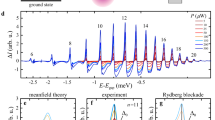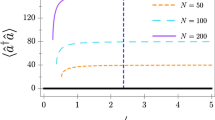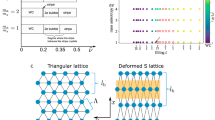Abstract
Symmetries are the underlying principles of fundamental interactions in nature. Chaos in a quantum system may emerge from breaking these symmetries. Compared to vacuum, crystals are attractive for studying quantum chaos, as they not only break spatial isotropy, but also lead to novel quasiparticles with modified interactions. Here we study yellow Rydberg excitons in cuprous oxide which couple strongly to the vacuum light field and interact significantly with crystal phonons, leading to inversion symmetry breaking. In a magnetic field, time-reversal symmetry is also broken and the exciton states show a complex splitting pattern, resulting in quadratic level repulsion for small splittings. In contrast to atomic chaotic systems in a magnetic field, which show only a linear level repulsion, this is a signature of a system where all anti-unitary symmetries are broken simultaneously. This behaviour can otherwise be found only for the electro-weak interaction or engineered billiards.
This is a preview of subscription content, access via your institution
Access options
Subscribe to this journal
Receive 12 print issues and online access
$259.00 per year
only $21.58 per issue
Buy this article
- Purchase on Springer Link
- Instant access to full article PDF
Prices may be subject to local taxes which are calculated during checkout




Similar content being viewed by others
References
Bohigas, O., Giannoni, M. J. & Schmit, C. Characterization of chaotic quantum spectra and universality of level fluctuation laws. Phys. Rev. Lett. 52, 1–4 (1984).
Frisch, A. et al. Quantum chaos in ultracold collisions of gas-phase erbium atoms. Nature 507, 475–479 (2014).
Zhou, W. et al. Magnetic field control of the quantum chaotic dynamics of hydrogen analogs in an anisotropic crystal field. Phys. Rev. Lett. 105, 024101 (2010).
Vina, L., Potemski, M. & Wang, W. Signatures of quantum chaos in the magneto-excitonic spectrum of quantum wells. Phys.-Usp. 41, 153–156 (1998).
Mitchell, G. E., Richter, A. & Weidenmüller, H. A. Random matrices and chaos in nuclear physics: nuclear reactions. Rev. Mod. Phys. 82, 2845–2901 (2010).
Robnik, M. & Berry, M. V. False time-reversal violation and energy level statistics: the role of anti-unitary symmetry. J. Phys. A 19, 669–682 (1986).
Thewes, J. et al. Observation of high angular momentum excitons in cuprous oxide. Phys. Rev. Lett. 115, 027402 (2015).
Wu, C. S., Ambler, E., Hayward, R. W., Hoppes, D. D. & Hudson, R. P. Experimental test of parity conservation in beta decay. Phys. Rev. 105, 1413–1415 (1957).
Ponomarenko, L. A. et al. Chaotic Dirac billiard in graphene quantum dots. Science 320, 356–358 (2008).
Brandt, J. et al. Ultranarrow optical absorption and two-phonon excitation spectroscopy of Cu2O paraexcitons in a high magnetic field. Phys. Rev. Lett. 99, 217403 (2007).
Kazimierczuk, T., Fröhlich, D., Scheel, S., Stolz, H. & Bayer, M. Giant Rydberg excitons in the copper oxide Cu2O. Nature 514, 343–347 (2014).
Wigner, E. P. Characteristic vectors of bordered matrices with infinite dimensions. Ann. Math. 62, 548–564 (1955).
Dyson, F. J. & Mehta, M. L. Statistical theory of the energy levels of complex systems. iv. J. Math. Phys. 4, 701–712 (1963).
Plerou, V., Gopikrishnan, P., Rosenow, B., Nunes Amaral, L. A. & Stanley, H. E. Universal and nonuniversal properties of cross correlations in financial time series. Phys. Rev. Lett. 83, 1471–1474 (1999).
Seligman, T. & Verbaarschot, J. Quantum spectra of classically chaotic systems without time reversal invariance. Phys. Lett. A 108, 183–187 (1985).
Brody, T. A. et al. Random-matrix physics: spectrum and strength fluctuations. Rev. Mod. Phys. 53, 385–479 (1981).
Weidenmüller, H. A. & Mitchell, G. E. Random matrices and chaos in nuclear physics: nuclear structure. Rev. Mod. Phys. 81, 539–589 (2009).
Stoffregen, U., Stein, J., Stöckmann, H.-J., Kuś, M. & Haake, F. Microwave billiards with broken time reversal symmetry. Phys. Rev. Lett. 74, 2666–2669 (1995).
So, P., Anlage, S. M., Ott, E. & Oerter, R. N. Wave chaos experiments with and without time reversal symmetry: GUE and GOE statistics. Phys. Rev. Lett. 74, 2662–2665 (1995).
Fröhlich, D. et al. Coherent propagation and quantum beats of quadrupole polaritons in Cu2O. Phys. Rev. Lett. 67, 2343–2346 (1991).
Schmutzler, J., Fröhlich, D. & Bayer, M. Signatures of coherent propagation of blue polaritons in Cu2O. Phys. Rev. B 87, 245202 (2013).
Beg, M. M. & Shapiro, S. M. Study of phonon dispersion relations in cuprous oxide by inelastic neutron scattering. Phys. Rev. B 13, 1728–1734 (1976).
Cartarius, H., Main, J. & Wunner, G. Exceptional points in atomic spectra. Phys. Rev. Lett. 99, 173003 (2007).
Cartarius, H., Main, J. & Wunner, G. Exceptional points in the spectra of atoms in external fields. Phys. Rev. A 79, 053408 (2009).
Gao, T. et al. Observation of non-hermitian degeneracies in a chaotic exciton-polariton billiard. Nature 526, 554–558 (2015).
Acknowledgements
We acknowledge the support by the Deutsche Forschungsgemeinschaft and the Russian Foundation for Basic Research in the frame of ICRC TRR 160 and the support from the Russian Ministry of Science and Education (contract number 14.Z50.31.0021).
Author information
Authors and Affiliations
Contributions
J.T. performed the experiments. M.A. analysed the data. D.F., M.B. and M.A. designed the experiment. M.A. and M.B. wrote the manuscript.
Corresponding author
Ethics declarations
Competing interests
The authors declare no competing financial interests.
Rights and permissions
About this article
Cite this article
Aßmann, M., Thewes, J., Fröhlich, D. et al. Quantum chaos and breaking of all anti-unitary symmetries in Rydberg excitons. Nature Mater 15, 741–745 (2016). https://doi.org/10.1038/nmat4622
Received:
Accepted:
Published:
Issue Date:
DOI: https://doi.org/10.1038/nmat4622
This article is cited by
-
Bloch theorem dictated wave chaos in microcavity crystals
Light: Science & Applications (2023)
-
Emergence and control of complex behaviors in driven systems of interacting qubits with dissipation
npj Quantum Information (2021)
-
The influence of Coulomb interaction screening on the excitons in disordered two-dimensional insulators
Scientific Reports (2021)
-
Auger processes in a single quantum dot
Nature Nanotechnology (2020)
-
Rydberg excitons in Cu2O microcrystals grown on a silicon platform
Communications Materials (2020)



